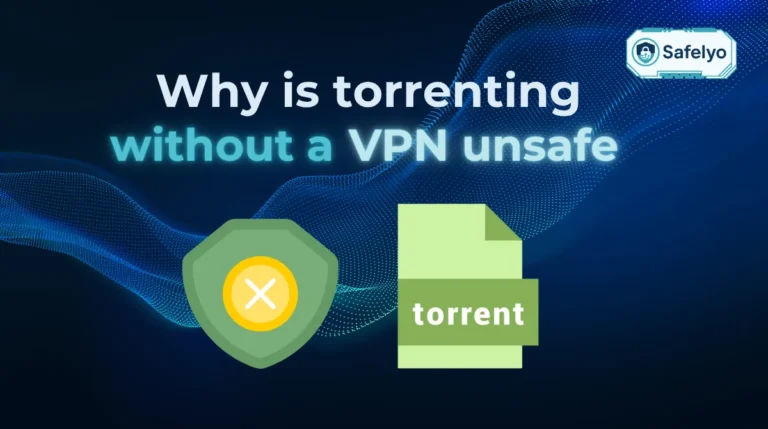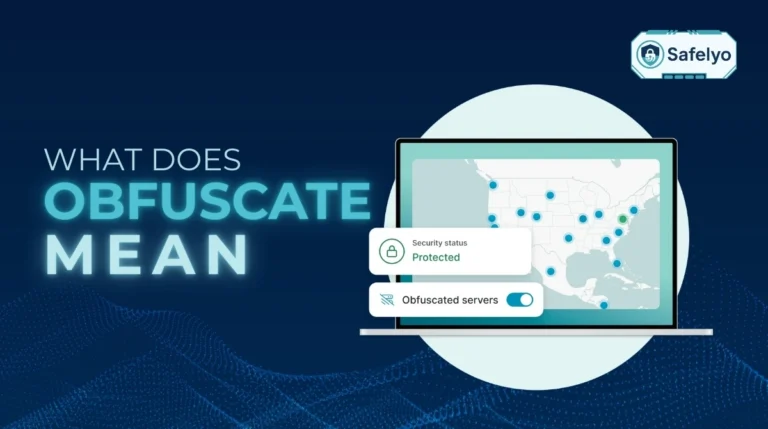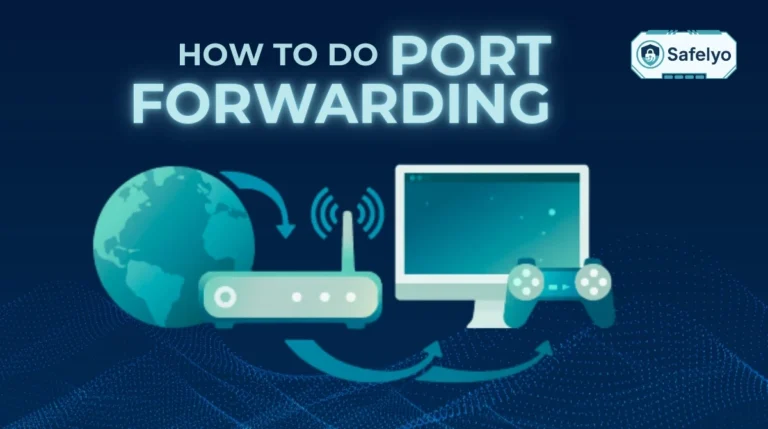When you connect your laptop to home Wi-Fi or use mobile data on the go, you’re relying on an internet service provider (ISP) even if you don’t think about it. Many people confuse Wi-Fi with an ISP, or are not sure how their devices actually reach the internet.
In this guide, I’ll cover:
- What an internet service provider (ISP) actually is
- The main services ISPs deliver
- How ISPs differ from Wi-Fi networks
Let’s start with the basics: What is an Internet Service Provider (ISP)?
1. What is an Internet Service Provider (ISP)?
An internet service provider is a telecommunications company that gives you access to the internet. As part of the broader telecommunications sector, ISPs also contribute to innovations in mobile and data services. Without an ISP, your devices, such as laptops, smartphones, or smart TVs, would not be able to connect to the web. ISPs manage the telecommunications physical facilities, such as fiber cables or cordless networks, that link your home or business to the global internet.
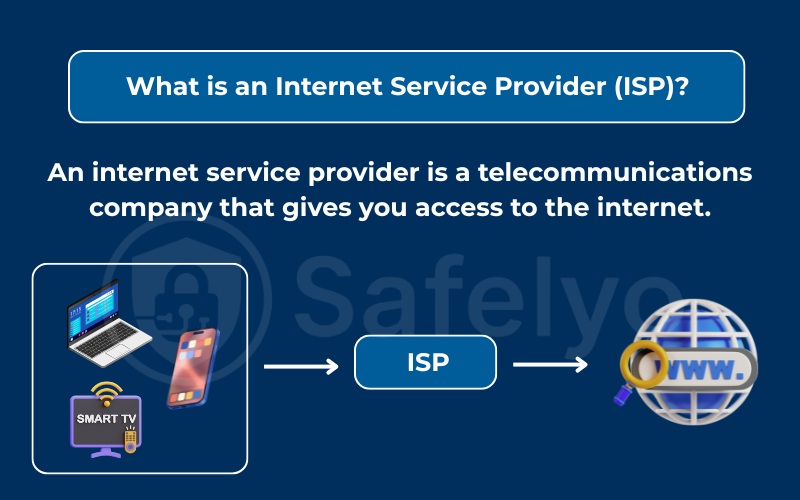
According to the Federal Communications Commission (FCC, 2024), ISPs are responsible for both delivering connectivity and ensuring service quality. That means they handle the “pipes” of the internet while also offering customer support, equipment, and sometimes extra features like security tools.
1.1. What does an ISP do?
ISPs provide the technical backbone that allows you to browse, stream, work, and game online. Their key responsibilities include:
- Supplying internet access through fiber, cable, Digital Subscriber Line, or cordless networks
- Assigning IP addresses to devices so they can communicate on the internet
- Offering additional services such as email accounts, cloud storage, or bundled phone/TV plans
When I assisted a friend in switching from Digital Subscriber Line to fiber, the ISP not only installed a new modem but also provided faster upload speeds. This improvement completely transformed her remote work experience.
1.2. Is an ISP the same as Wi-Fi?
No. Wi-Fi is the wireless technology that connects your devices to a router inside your home or office. The ISP is the company that connects the router to the wider internet. In simple terms:
- ISP = service provider (the company)
- Wi-Fi = local connection (the technology inside your space)
Many people assume that “my Wi-Fi is down” means the Wi-Fi itself failed, when in reality, it is often an ISP outage.
1.3. What services do ISPs provide?
Beyond basic internet access, most ISPs also provide:
- Email services (though less common today with Gmail or Outlook)
- VoIP or landline phone options
- TV streaming bundles with set-top boxes
- Security features such as parental controls, spam filters, or even basic antivirus tools
- Web hosting or domain services for enterprises that need to run websites. Some providers even include web hosting as part of premium business packages.
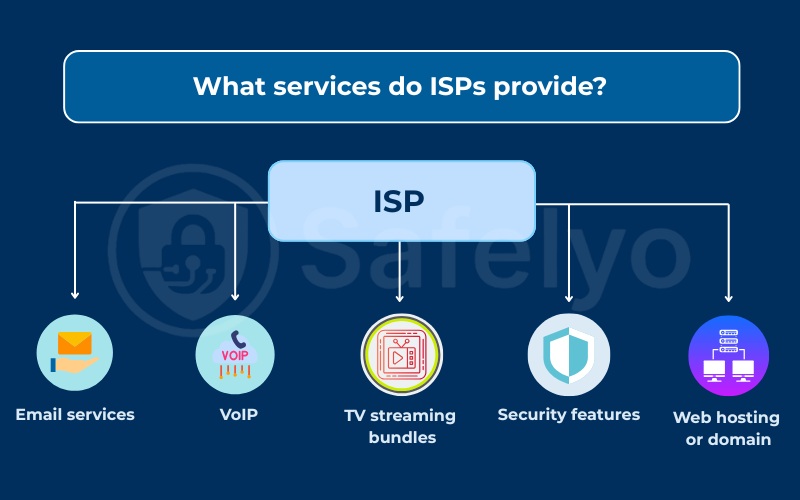
Some ISPs, like Comcast or AT&T in the U.S., market these as bundled “triple play” or “quad play” services. Small enterprises often rely on ISPs not only for connectivity but also for static IP addresses to host websites or servers. On the other hand, home consumers often care more about streaming quality, gaming performance, and affordable packages than technical details.
2. How does an ISP connect you to the internet
Your ISP uses a combination of physical facilities and digital routing to link your home or business to the global network. The process may seem invisible, but it involves several important steps. Understanding this helps explain why speed, stability, and coverage can vary so much between providers.
2.1. What is the “last mile” in internet service?
The “last mile” is the final stretch of the network that connects your ISP’s physical facilities to your home or office. It can take different forms:
- Fiber optics lines for high-speed connections. This is possible thanks to optical fibers cables that minimize resistance and maximize speed.
- Dial-up over telephone lines (largely obsolete today). Even now, some rural areas keep dial-up as a backup option when broadband is unavailable.
- Coaxial cables in cable-based internet services
- Twisted copper pairs in DSL connections
- Wireless signals for fixed wireless or fifth-generation access
When I upgraded to fiber internet, the biggest improvement came from replacing the old copper “last mile” with a direct fiber line. This change nearly doubled my upload speed and made video conferencing far smoother.
2.2. What are peering and transit connections?
ISPs do not operate in isolation. They must connect with other networks to deliver worldwide access. This happens through:
- Peering: An agreement where two ISPs exchange traffic directly, often without charging each other. This helps improve speed and reduce costs.
- Transit: When a smaller ISP pays a larger one for access to parts of the internet it cannot reach directly. This process requires advanced network routing to make sure your data travels efficiently.
According to APNIC (2023), peering and transit agreements are critical for maintaining efficient global routing and ensuring that data flows reliably between different providers. At its core, the internet relies on seamless data transport between interconnected providers. For instance, when you stream a video hosted overseas, your ISP may depend on multiple transit partners before the content reaches your device.
3. Main types of ISPs
Various connection types influence not only speed but also stability and service cost. Internet Service Providers (ISPs) utilize different technologies for connectivity. The available service options depend on local infrastructure, pricing, and demand. Each type of connection presents trade-offs regarding speed and coverage.
3.1. Fiber internet
Fiber optics technology makes this possible by transmitting data as light signals through ultra-thin glass strands. Because light travels faster and with less resistance than electricity over copper, fiber provides extremely high speeds with minimum delay.
- Speeds: Up to 1–10 Gbps for both uploads and downloads
- Best for: Remote work, cloud backups, online gaming, and streaming in 4K or 8K
- Limitation: Limited rollout in rural areas due to the cost of laying fiber lines
When I switched from DSL to fiber, video calls became instantly smoother. Even with four devices streaming at once, there was no buffering.
3.2. Cable Internet
Cable internet relies on coaxial cables originally built for television service. It offers strong download speeds but typically weaker upload speeds.
- Speeds: Ranges from 100 Mbps to 1 Gbps download, uploads often capped at 35 Mbps
- Best for: Households with multiple streamers and gamers who don’t upload large files frequently
- Limitation: Shared bandwidth can cause slowdowns during evening peak hours
According to FCC data (2024), cable remains the most widely available broadband option in the U.S.
3.3. DSL internet
DSL, or Digital Subscriber Line, uses standard telephone lines to transmit the internet. While slower than cable or fiber, it provides a dedicated line, so speeds remain steady regardless of neighbors’ usage.
- Speeds: Usually 5–100 Mbps download, 1–10 Mbps upload
- Best for: Light browsing, email, and smaller households
- Limitation: Distance matters; the farther your home is from the provider’s central office, the slower the connection
In rural areas, DSL is often the only wired option available.
3.4. 5G and fixed wireless internet
Fixed wireless and fifth-generation home internet connect your home router to nearby cellular towers. Some areas also offer 4G home internet as a more affordable alternative. Unlike wired services, no cables are required.
- Speeds: Typically 50 Mbps to 1 Gbps, depending on signal strength and network congestion
- Best for: Urban and suburban areas where 5G towers are widespread
- Limitation: Performance can fluctuate with weather, building interference, or high network traffic
During a trip, I tested a fifth-generation home internet service. At night, I measured 200 Mbps, but during the day, it sometimes dropped below 50 Mbps due to congestion.
3.5. Satellite internet access
Satellite internet connects users through a dish antenna that communicates with satellites orbiting Earth. It is often the only option for remote or rural areas.
- Traditional providers: HughesNet, Viasat (geostationary satellites with higher latency)
- New providers: Starlink and OneWeb (low-Earth orbit satellites with reduced latency)
- Speeds: 25–250 Mbps download, with latency ranging from 20 ms (LEO) to 600 ms (traditional)
- Best for: Areas without fiber, cable, or DSL access. This makes satellites especially valuable in remote areas where wired networks are not feasible.
- Limitation: Weather interference, higher costs, and data caps
For someone living in the mountains oron a rural farm, satellite may be the only way to stay connected, though gaming and real-time video calls may still feel delayed.
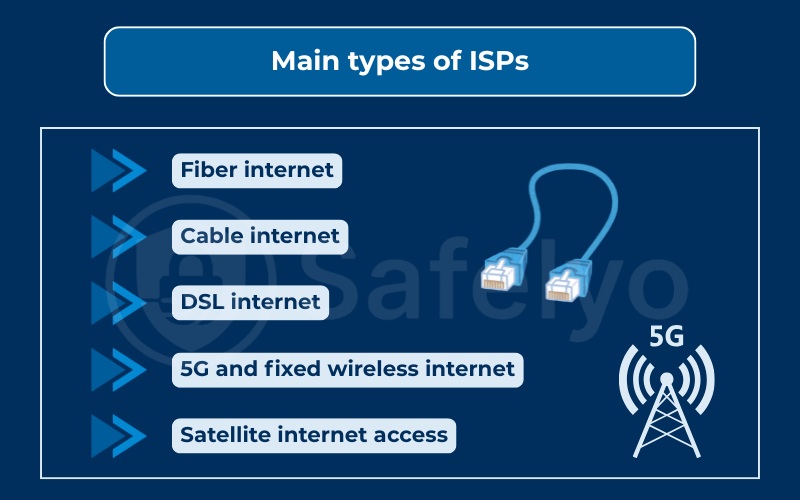
4. What are ISP network tiers
Not all ISPs operate at the same level. ISPs are categorized into tiers based on the size of their networks, who they connect with, and whether they pay for or sell access to other providers. These tiers explain why some providers control global internet traffic while others only serve local communities.
4.1. What is a Tier-1 ISP?
A Tier 1 ISP is a provider that owns a massive global backbone network and can reach every other part of the internet without paying another provider for transit. These Tier 1 ISPs play a critical role in ensuring international connectivity remains fast and stable. They exchange traffic directly through peering agreements. Here are the key traits of Tier 1 ISPs:
- Examples: AT&T, Verizon, NTT, CenturyLink (Lumen)
- Role: They form the “spine” of the internet, carrying huge amounts of international traffic
- Why it matters: Tier-1 ISPs control costs and routing efficiency because they don’t depend on anyone else
According to Ars Technica (2023), Tier-1 providers are essentially “wholesalers” of internet bandwidth, while local ISPs act as retailers for end users.
4.2. What are Tier-2 and Tier-3 ISPs?
Tier-2 and Tier-3 ISPs serve more regional and local roles. They differ in how much infrastructure they own and how they connect to the wider internet.
Tier-2 ISPs:
These providers own significant infrastructure but still pay Tier-1 providers for some transit. They often serve national or regional markets and maintain a mix of peering and customer-facing services.
- Examples: Comcast, BT, Deutsche Telekom
- Strength: Good balance between coverage and affordability
Tier-3 ISPs:
These providers focus on delivering internet directly to homes and enterprises. They purchase most of their connectivity from Tier-1 or Tier-2 providers and are often called “last-mile” operators.
- Examples: Local cable companies or municipal ISPs
- Strength: Provide personalized service and community coverage
In simple terms:
- Tier-1 = backbone carriers
- Tier-2 = regional operators
- Tier-3 = local ISPs serving end users
This breakdown makes it easier to understand what is an ISP in practice, since each tier plays a different role in how the internet reaches customers.
5. What equipment do you need for an ISP
To connect to the internet through your ISP, you need certain hardware at home or in your office. This equipment helps translate the ISP’s signal into a usable connection for your devices.
5.1. Do you need a modem or router?
The modem and router are two of the most important pieces of equipment. Each has a different role:
- Modem: Connects directly to your ISP’s line (fiber, conductive wire, or DSL) and translates the signal into internet data.
- Router: Distributes that connection to multiple devices, usually via Wi-Fi or Ethernet conductive wires.
- Combo units: Many ISPs provide modem–router combos, which are convenient but less flexible if you want advanced features like parental controls or gaming optimization.
In short, both a modem and a router are required to bring the internet into your home and share it across devices.
5.2. What is mesh Wi-Fi?
A single router often struggles to cover a large house or an office with thick walls. That’s where mesh Wi-Fi comes in. Instead of relying on one device, you use multiple access points that work together. The benefits include:
- Seamless coverage: Devices switch automatically between nodes as you move around
- Flexibility: You can add more nodes to cover larger areas
- Better stability: Reduces dead zones compared to a single router
Overall, mesh Wi-Fi is a practical solution for ensuring strong and reliable coverage in larger spaces.
6. How IP addresses and DNS work with ISPs
Every time you go online, your ISP assigns your device an IP address through IP addressing and uses DNS (Domain Name System) servers to help you reach websites. These two elements are essential for making the internet usable.
6.1. What is a dynamic vs static IP?
ISPs typically assign IP addresses in two different ways:
- Dynamic IP: Changes automatically over time. Most home users receive this type because it conserves the ISP’s address pool.
- Static IP: Remains fixed. Businesses often use it for hosting websites, email servers, or remote access.
Dynamic IPs are more common, while static IPs are useful when stability and accessibility are critical.
6.2. What’s the difference between IPv4 and IPv6?
There are two main versions of IP addresses in use today:
- IPv4: The older standard, using a 32-bit format (e.g., 192.168.1.1). Limited to about 4.3 billion unique addresses.
- IPv6: The newer 128-bit format, allowing for virtually unlimited addresses (e.g., 2001:0db8:85a3:0000:0000:8a2e:0370:7334).
IPv6 adoption is increasing, but many ISPs still support both versions to maintain compatibility with older systems.
6.3. How does DNS affect security?
DNS servers act like the internet’s phone book, converting domain names (like google.com) into numerical IP addresses. Security concerns arise because:
- Unencrypted DNS queries can be intercepted by attackers or monitored by ISPs
- Malicious redirects may send users to fake websites designed for phishing
- Secure alternatives such as DNS over HTTPS (DoH) or DNS over TLS (DoT) encrypt requests to improve privacy
According to CISA (2024), using encrypted DNS protocols helps protect against data interception and reduces the risk of man-in-the-middle attacks.
In summary, both IP addresses and DNS are fundamental for connectivity, and securing them improves both reliability and privacy.
7. What privacy and security issues do ISPs have
ISPs provide essential access to the internet, but they also raise concerns about privacy and data protection. Because your traffic passes through their systems, ISPs have visibility into your online activity and may be subject to legal, commercial, or security obligations.
7.1. Can ISPs see your browsing history?
In most cases, yes. ISPs can log metadata such as:
- Websites you visit (domain names)
- Times and durations of connections
- Devices used on your network
They usually cannot see the exact content of encrypted traffic (like HTTPS websites), but they can still track which domains you access.
In the U.S., ISPs are legally allowed to collect and even sell anonymized user data unless customers opt out. The Electronic Frontier Foundation (EFF, 2023) warns that this creates risks for user privacy.
7.2. What is net neutrality?
Net neutrality is the principle that ISPs should treat all internet traffic equally. Without it, ISPs could:
- Throttle connections to certain websites or apps
- Prioritize paid services over competitors
- Restrict access to specific types of content
This debate is ongoing in many countries. Supporters argue that net neutrality ensures a fair and open internet, while opponents say ISPs need flexibility to manage network congestion.
7.3. How do ISPs handle security?
ISPs implement several measures to protect their infrastructure and users. These security measures are designed to defend both the network backbone and end-user connections, such as:
- Firewalls and intrusion detection systems to block malicious traffic
- Spam and phishing filters for email platforms
- DDoS protection to defend against large-scale attacks
- Parental controls and optional security add-ons for customers
While these protections help reduce threats, ultimate responsibility for device and account security rests with the user. Using antivirus software, enabling multi-factor authentication, and considering a VPN are effective ways to strengthen personal protection.
In conclusion, ISPs play a central role in both enabling and monitoring online activity, which makes understanding their privacy and security practices essential for every internet user.
8. How to choose the right ISP
Selecting an ISP is more than just picking the cheapest option. Factors like availability, speed, contract terms, and hidden fees can make a big difference in your experience.
8.1. Step 1 – Check which ISPs are available in your area
The first step is to see which providers actually operate in your location. Availability can vary by city, neighborhood, or even street.
- Tools: Use ISP availability checkers on provider websites or government broadband maps. Popular options include HighSpeedInternet.com, BroadbandNow, or official sources like the FCC Broadband Map in the U.S.
- Tip: Ask neighbors or local businesses which services they use and how reliable they are
Knowing your options ensures you don’t waste time comparing providers that cannot serve your address.
8.2. Step 2 – Compare internet speed and data plans with your needs
Once you know your choices, compare plans based on how you use the internet. Different households and businesses need different levels of speed and data.
- Light use: Browsing, email, and streaming in HD typically need 25–50 Mbps
- Heavy use: Multiple 4K streams, gaming, or large file uploads may require 200 Mbps or more
- Business use: Look for higher upload speeds and consider static IPs if hosting servers
Matching the plan to your actual usage prevents overpaying for speed you do not need.
8.3. Step 3 – Review pricing, contracts, and hidden fees before signing
Price is often the deciding factor, but ISPs may include extra costs beyond the advertised monthly fee. Common fees include:
- Installation or activation fees
- Equipment rental charges for modems and routers
- Early termination penalties if you cancel before the contract ends
- Data overage fees if you exceed monthly limits
You should also check if the monthly subscription fee is included in the advertised price. Reading the fine print helps you avoid unpleasant surprises and ensures you know the true long-term cost.
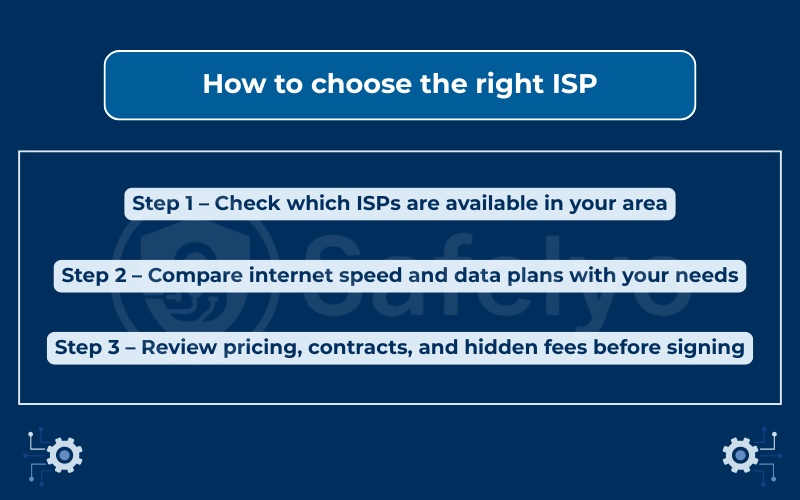
In summary, choosing the right ISP requires checking availability, comparing speed plans to your needs, and carefully reviewing the total cost of service.
9. When should you use a VPN with your ISP
Even if you have a reliable ISP, there are times when adding a VPN (Virtual Private Network) improves your security and privacy. A VPN encrypts your internet traffic and routes it through a secure server, making it harder for your ISP or other parties to monitor your activity.
You should consider using a VPN in situations such as:
- Public Wi-Fi: Protects your data from potential snooping on shared networks
- Traveling abroad: Helps access services from your home country and avoid regional restrictions
- Privacy concerns: Prevents your ISP from logging and selling details about your browsing habits
- Bypassing restrictions: Useful if your ISP throttles streaming services or certain websites
According to CISA (2024), VPNs are one of the most effective tools for securing data when using untrusted or public networks. While they don’t replace good cybersecurity practices, they add an important extra layer of protection.
A VPN is especially valuable when you want stronger privacy, safer public browsing, or more control over your online experience.
>> Read more:
10. Examples of ISPs
ISPs range from global corporations to small local companies. The providers available to you depend on your region and infrastructure.
Some common examples include:
- United States: Comcast (Xfinity), AT&T, Verizon, Spectrum
- Europe: BT (UK), Orange (France), Deutsche Telekom (Germany)
- Asia: NTT (Japan), Singtel (Singapore), Jio (India)
- Global satellite providers: Starlink, Viasat, HughesNet
Many of these companies not only sell connectivity but also offer add-ons such as cloud services, domain registration, and web hosting packages for businesses. For small enterprises, bundled domain registration services simplify the process of going online.
11. FAQs about the ISP – internet service provider
Many people still have basic questions about ISPs, especially when it comes to how they work and what services they actually provide. Here are some of the most common questions and answers.
What are ISP providers?
ISP providers are companies that supply internet access to homes, businesses, and organizations. They handle the infrastructure, assign IP addresses, and often bundle extra services like email or TV.
What is an ISP in simple terms?
An ISP is the company that connects you to the internet. Without it, your computer or phone would not be able to load websites or use online apps.
Can I access the internet without an ISP?
Not directly. To connect to the wider internet, you need an ISP. However, you can use a mobile hotspot or tethering plan, which still relies on a mobile carrier acting as your ISP.
Do ISPs provide Wi-Fi?
ISPs usually provide a modem or a modem–router combo with built-in Wi-Fi. The ISP itself does not “create” Wi-Fi but supplies the connection that your router broadcasts wirelessly.
Why do different ISPs offer different speeds?
Speeds vary because of the technology used (fiber, conductive wire, DSL, or satellite), the quality of infrastructure, and how much bandwidth is shared among customers in your area.
In short, ISPs differ in coverage, speed, which is why comparing providers carefully is important before choosing one.
12. Conclusion
Understanding “what is an internet service provider” is essential for anyone who uses the web daily. ISPs are the backbone of your connectivity, and knowing how they work helps you make smarter decisions about speed, privacy, and security.
Key takeaways from this guide:
- ISPs connect you to the internet through fiber, conductive wire, Digital Subscriber Line, wireless, or satellite technologies
- They assign IP addresses and manage DNS, which are critical for online access
- Privacy and security concerns mean ISPs can see some of your activity unless you use extra protection
- Choosing the right ISP requires checking availability, speeds, and total costs before committing
- A VPN adds an extra layer of privacy, especially on public or shared networks
In my own experience, switching providers and upgrading equipment dramatically improved both speed and reliability at home. It showed how much the right ISP choice can affect everyday work and entertainment.
Take the time to evaluate your options carefully, and remember that extra tools like VPNs or mesh Wi-Fi can enhance your experience.
For more practical guides on internet safety and technology, explore the Privacy & Security Basics section at Safelyo.


